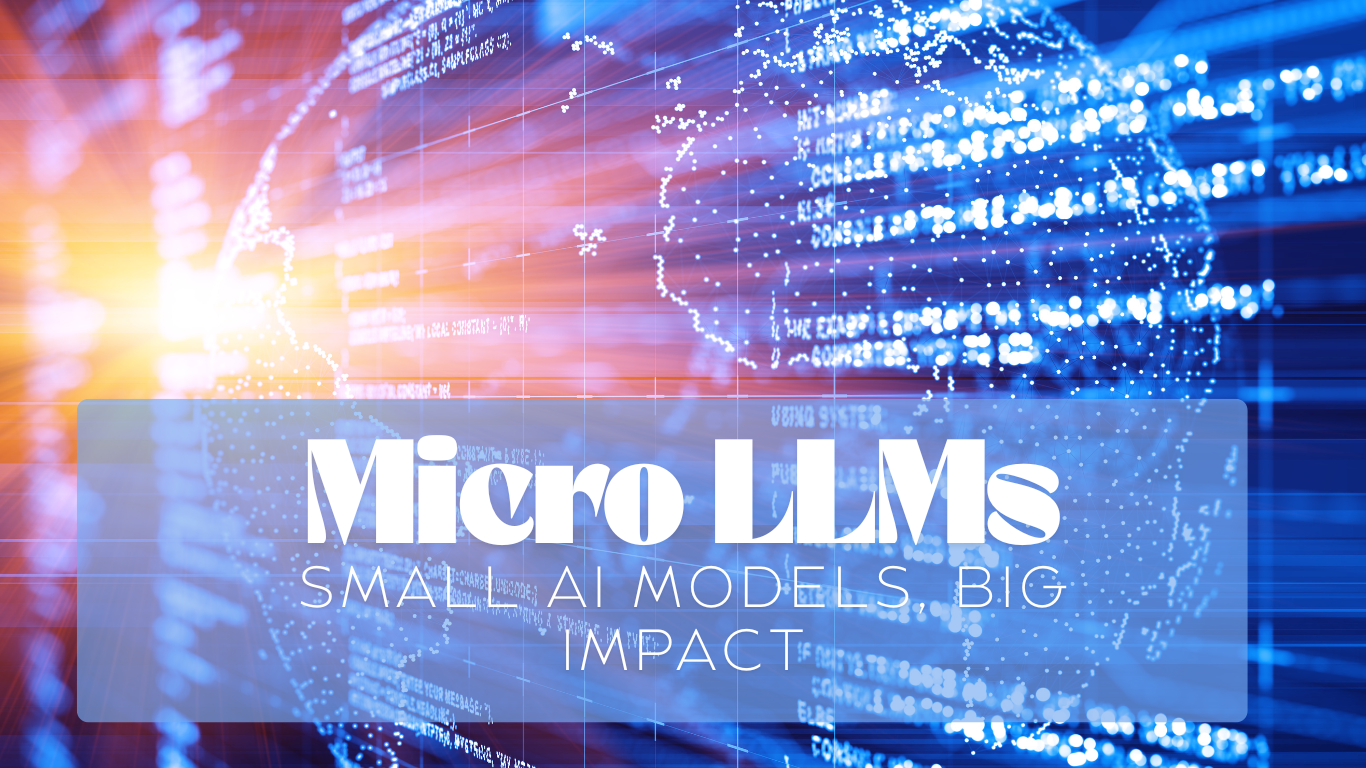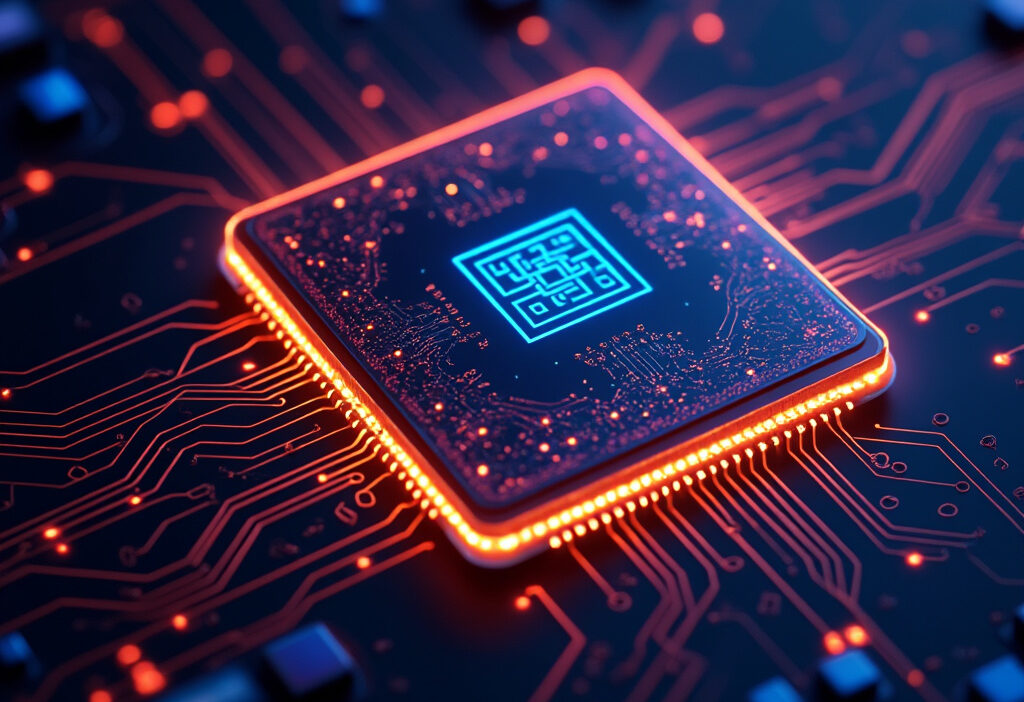Exploring Micro Large Language Models (Micro LLMs) The Future of Compact AI
Micro Large Language Models (Micro LLMs) represent a groundbreaking shift in artificial intelligence, offering the power of large language models in a more compact and efficient form. This article delves into the essence of Micro LLMs, their development, and their transformative potential across industries. From their technical foundations to practical applications, we explore how these models are shaping the future of AI.
The Genesis of Micro LLMs
The origins of Micro Large Language Models (Micro LLMs) can be traced back to the growing need for efficient, scalable AI solutions that balance performance with resource constraints. While traditional LLMs like GPT-3 and BERT demonstrated the transformative potential of AI, their massive computational demands made them impractical for many real-world applications. This gap inspired researchers to explore smaller, yet capable alternatives—leading to the birth of Micro LLMs.
The development of Micro LLMs was fueled by several key advancements. Model distillation, a technique where a smaller model is trained to mimic the behavior of a larger one, played a pivotal role. By transferring knowledge from expansive architectures to compact ones, researchers preserved critical linguistic capabilities while drastically reducing size. Additionally, innovations in quantization—reducing numerical precision of model weights—and pruning, which removes redundant neurons, further optimized these models without significant performance degradation.
Another driving force was the rise of edge computing, where processing occurs closer to data sources rather than in centralized clouds. Micro LLMs, with their leaner architectures, became ideal for deployment on devices with limited memory and processing power, such as smartphones and IoT gadgets. Frameworks like TensorFlow Lite and ONNX Runtime enabled efficient execution, making them accessible to a broader range of applications.
The shift toward Micro LLMs also reflects a broader trend in AI—prioritizing practical utility over sheer scale. By focusing on targeted use cases, these models deliver specialized performance where larger models would be overkill. This evolution marks a critical step in democratizing AI, ensuring powerful language understanding is available beyond data centers and tech giants. The next chapter will delve into how their architecture achieves this delicate balance of efficiency and capability.
Understanding the Architecture
Micro Large Language Models (Micro LLMs) distinguish themselves from their larger counterparts through deliberate architectural optimizations that prioritize efficiency while maintaining competitive performance. Unlike traditional LLMs, which rely on massive parameter counts—often in the billions—Micro LLMs employ strategic reductions in model size without sacrificing critical capabilities.
One key architectural difference lies in parameter efficiency. Micro LLMs leverage techniques like knowledge distillation, where a smaller model is trained to replicate the behavior of a larger one, capturing essential patterns while discarding redundant parameters. Additionally, pruning removes less significant weights post-training, streamlining the model. Another approach is quantization, which reduces numerical precision (e.g., from 32-bit to 8-bit floats), shrinking memory footprint without drastic performance loss.
Attention mechanisms are also optimized. While traditional LLMs use computationally expensive full self-attention, Micro LLMs adopt sparse attention or local attention windows, limiting the scope of token interactions to reduce overhead. Some architectures integrate mixture-of-experts (MoE) designs, where only a subset of model pathways activate per input, cutting unnecessary computations.
Embedding compression further enhances efficiency. Instead of high-dimensional token embeddings, Micro LLMs use techniques like hashing embeddings or low-rank approximations to reduce dimensionality while preserving semantic relationships.
Finally, hardware-aware design ensures Micro LLMs align with edge-device constraints. By optimizing for on-device inference, these models minimize latency and power consumption, making them viable for mobile and IoT applications.
These architectural refinements enable Micro LLMs to deliver surprising performance despite their compact size, setting the stage for their role in specialized, resource-constrained environments—a theme further explored in the next chapter on training and fine-tuning.
Training and Fine-Tuning
Training and fine-tuning Micro LLMs involve specialized approaches tailored to their compact architecture. Unlike their larger counterparts, which rely on massive datasets and extensive computational power, Micro LLMs prioritize efficiency in both data and resource utilization. The training process begins with carefully curated datasets, often smaller but highly relevant to the intended use case. This selective data ingestion ensures the model learns meaningful patterns without unnecessary bloat, aligning with the streamlined nature of Micro LLMs.
Computational resources are another critical factor. While traditional LLMs demand high-end GPUs or TPU clusters, Micro LLMs can be trained on modest hardware, sometimes even on a single GPU or edge devices. Techniques like quantization (reducing numerical precision of weights) and pruning (removing redundant neurons) further optimize resource usage. These methods not only cut training costs but also make iterative fine-tuning more accessible for developers working with limited infrastructure.
Fine-tuning for specific applications is where Micro LLMs truly shine. Their smaller size allows for rapid adaptation to niche tasks, such as customer support chatbots or domain-specific text analysis. Techniques like transfer learning (leveraging pre-trained knowledge) and few-shot learning (training with minimal examples) are particularly effective. For instance, a Micro LLM fine-tuned for medical terminology can outperform larger general-purpose models in healthcare applications, as covered in the next chapter.
Key considerations during fine-tuning include:
- Task-specific data augmentation to enhance learning with limited samples.
- Layer freezing to retain foundational knowledge while updating only relevant parts of the model.
- Regularization techniques to prevent overfitting, crucial given the smaller training datasets.
By focusing on precision over scale, Micro LLMs achieve remarkable performance in targeted scenarios, paving the way for their widespread adoption across industries, as explored in the following chapter.
Applications Across Industries
Micro Large Language Models (Micro LLMs) are rapidly transforming industries by offering specialized, efficient, and scalable AI solutions tailored to specific needs. Unlike their larger counterparts, which often require extensive computational power, Micro LLMs excel in niche applications where precision and resource efficiency are paramount.
In healthcare, Micro LLMs are revolutionizing diagnostics and patient care. They power personalized treatment recommendations by analyzing patient histories and medical literature without the latency of cloud-based systems. For instance, compact models deployed on edge devices assist doctors in real-time during surgeries by processing medical notes or suggesting drug interactions, all while maintaining strict data privacy.
The finance sector leverages Micro LLMs for fraud detection and automated customer support. Banks integrate these models into mobile apps to analyze transaction patterns instantly, flagging anomalies with minimal latency. Their small footprint allows deployment on local servers, ensuring sensitive financial data never leaves secure environments. Additionally, Micro LLMs enable dynamic financial advising, parsing market trends and generating insights tailored to individual portfolios.
In education, Micro LLMs facilitate adaptive learning platforms that adjust content based on student performance. Schools with limited IT infrastructure benefit from models that run offline, providing instant feedback on assignments or generating customized study guides. Language learning apps, for example, use Micro LLMs to offer context-aware corrections and conversational practice without relying on massive cloud APIs.
Even manufacturing and retail harness these models for predictive maintenance and inventory optimization. Factories deploy Micro LLMs on IoT devices to predict equipment failures, while retailers use them to analyze customer behavior in real-time, optimizing stock levels dynamically.
The versatility of Micro LLMs lies in their ability to deliver high-impact solutions without the overhead of traditional LLMs, making them indispensable across industries. Their adoption signals a shift toward leaner, faster, and more accessible AI, perfectly aligning with the demand for agile technological integration.
Advantages Over Traditional LLMs
Micro Large Language Models (Micro LLMs) offer distinct advantages over their traditional counterparts, particularly in scenarios where efficiency and practicality outweigh the need for massive scale. While traditional LLMs like GPT-4 or PaLM excel in raw performance, their resource demands make them impractical for many real-world applications. Micro LLMs, however, strike a balance by delivering sufficient performance while drastically reducing computational overhead.
One of the most compelling benefits is resource efficiency. Traditional LLMs require high-end GPUs or TPUs, consuming significant energy and incurring substantial operational costs. Micro LLMs, optimized for smaller parameter counts, can run on consumer-grade hardware, edge devices, or even embedded systems. This makes them ideal for applications like real-time customer support chatbots or on-device voice assistants, where latency and power consumption are critical.
Deployment flexibility is another key advantage. Unlike traditional models that often rely on cloud infrastructure, Micro LLMs can operate offline or in low-bandwidth environments. This is transformative for industries like healthcare, where data privacy regulations may restrict cloud-based processing, or in remote education, where internet access is unreliable. Their compact size also enables faster updates and customization, allowing organizations to fine-tune models for niche use cases without extensive retraining.
Finally, Micro LLMs are cost-effective. Training and maintaining traditional LLMs involves millions in compute costs, limiting access to well-funded entities. Micro LLMs reduce these barriers, democratizing AI for startups, SMEs, and individual developers. Lower inference costs further enhance their appeal, making them sustainable for long-term deployment at scale.
While they may not match traditional LLMs in sheer capability, their efficiency, adaptability, and affordability position Micro LLMs as a pragmatic choice for modern AI applications—bridging the gap between cutting-edge research and real-world usability.
Challenges and Limitations
While Micro LLMs offer compelling advantages in resource efficiency and deployment flexibility, they are not without their challenges and limitations. One of the most significant trade-offs is performance. Due to their compact architecture, Micro LLMs often struggle with complex language tasks that larger models handle effortlessly. Tasks requiring deep contextual understanding, nuanced reasoning, or extensive knowledge retrieval may suffer in accuracy or coherence. This performance gap becomes especially apparent in specialized domains like legal analysis or medical diagnostics, where precision is critical.
Another pressing issue is data bias. Like their larger counterparts, Micro LLMs inherit biases from their training datasets. However, their smaller size means they have less capacity to mitigate these biases through fine-tuning or additional layers of abstraction. This can lead to amplified biases in outputs, particularly when deployed in edge devices or applications with limited oversight. For instance, a Micro LLM powering a customer service chatbot might inadvertently reinforce stereotypes if its training data lacks diversity.
Scalability also poses a challenge. While Micro LLMs excel in lightweight applications, scaling them to handle diverse or high-volume tasks without significant performance degradation remains difficult. Their constrained parameter count limits their ability to generalize across multiple use cases simultaneously, often requiring task-specific variants—which undermines some of their cost and efficiency benefits.
Finally, energy efficiency, often touted as a strength, can become a limitation when deployed in resource-constrained environments. Optimizing inference speed without sacrificing too much accuracy is a delicate balance, and poorly optimized Micro LLMs may end up consuming more energy per useful output than anticipated.
These challenges highlight the need for ongoing research into model compression techniques, bias mitigation strategies, and adaptive architectures to unlock the full potential of Micro LLMs without compromising their core advantages.
Ethical Considerations
The deployment of Micro Large Language Models (Micro LLMs) raises significant ethical questions that must be addressed to ensure their responsible integration into modern technology. Unlike their larger counterparts, Micro LLMs are designed for efficiency and accessibility, but their compact nature does not exempt them from ethical scrutiny. Privacy concerns are paramount, as these models often operate on edge devices or in environments with limited oversight, potentially processing sensitive user data without robust safeguards. Ensuring data anonymization and minimizing unnecessary data retention are critical steps to mitigate risks.
Another pressing issue is the potential misuse of Micro LLMs. Their affordability and ease of deployment make them attractive for malicious applications, such as generating disinformation, automating spam, or creating deepfake content at scale. The democratization of AI through smaller models must be balanced with safeguards, including strict usage policies and embedded ethical guidelines within the models themselves.
Responsible AI development is equally crucial. While the previous chapter highlighted technical limitations like biases and scalability, ethical development demands proactive measures to address these flaws. Developers must prioritize transparency in training data sources, implement bias detection mechanisms, and ensure that Micro LLMs are not deployed in high-stakes scenarios without proper validation.
Finally, the ethical implications extend to environmental impact. Though Micro LLMs consume fewer resources than traditional LLMs, their widespread adoption could still contribute to energy waste if not optimized sustainably. Ethical AI must consider not just immediate functionality but long-term consequences, aligning innovation with societal well-being. As the field progresses, these considerations will shape whether Micro LLMs become a force for good or an unchecked liability.
Future Developments
The rapid evolution of Micro Large Language Models (Micro LLMs) suggests a future where compact AI systems will redefine efficiency, accessibility, and adaptability in technology. As hardware becomes more powerful and energy-efficient, we anticipate breakthroughs in model compression techniques, enabling Micro LLMs to achieve performance closer to their larger counterparts while maintaining minimal footprints. Quantization, pruning, and knowledge distillation will likely advance, allowing these models to run seamlessly on edge devices—from smartphones to IoT sensors—without sacrificing accuracy.
Emerging trends point toward specialized Micro LLMs tailored for niche applications, such as medical diagnostics, legal analysis, or real-time language translation. These models could leverage domain-specific datasets, fine-tuned to deliver expert-level insights while operating under strict computational constraints. Additionally, federated learning may empower decentralized training, preserving privacy by keeping data localized while still improving model intelligence.
Long-term, Micro LLMs could democratize AI, making advanced language processing accessible to startups and developing regions with limited infrastructure. Their integration into everyday tools—like wearables, smart home systems, or educational apps—could personalize user experiences without relying on cloud-based servers. However, this shift will demand robust on-device security to prevent exploitation, building on the ethical frameworks discussed earlier.
Another exciting frontier is self-improving Micro LLMs, capable of incremental learning without catastrophic forgetting. Combined with neuromorphic computing, these models might mimic human-like adaptability, opening doors for AI companions or autonomous agents that evolve with user interactions. As case studies in the next chapter will demonstrate, the practical applications of Micro LLMs are already emerging—but the future holds even greater potential as these compact systems become smarter, faster, and more ubiquitous.
Case Studies
Micro Large Language Models (Micro LLMs) are already making waves across industries, proving their value in real-world applications. One notable case study involves customer support automation for a mid-sized e-commerce platform. By deploying a Micro LLM fine-tuned on product descriptions and FAQs, the company reduced response times by 40% while maintaining accuracy comparable to human agents. The model’s compact size allowed it to run efficiently on edge devices, cutting cloud costs by 30%. Key lessons included the importance of domain-specific fine-tuning and the need for continuous feedback loops to refine responses.
Another compelling example comes from healthcare, where a Micro LLM was integrated into a mobile app for symptom checking. Trained on medical literature and anonymized patient data, the model provided preliminary assessments with 85% accuracy, aiding rural clinics with limited access to specialists. The lightweight architecture ensured offline functionality, critical in low-connectivity areas. Challenges included balancing model simplicity with diagnostic precision, underscoring the trade-offs inherent in Micro LLM design.
In education, a language-learning app leveraged a Micro LLM to personalize exercises based on student progress. The model’s low latency enabled real-time feedback, improving engagement by 25%. Developers noted that pruning redundant parameters during training was essential to maintain performance without bloating the model.
These cases highlight Micro LLMs’ adaptability, cost-efficiency, and edge compatibility. However, they also reveal common pitfalls: over-optimizing for size at the expense of capability, or underestimating data quality requirements. As the field evolves, these lessons will shape best practices, bridging the gap between theoretical potential and practical implementation—a natural segue into the next chapter’s focus on getting started with Micro LLMs.
Getting Started with Micro LLMs
Getting started with Micro LLMs requires a blend of foundational knowledge, the right tools, and an understanding of best practices to maximize their potential. For beginners, the first step is selecting the appropriate framework. Hugging Face’s Transformers and TensorFlow Lite are popular choices, offering pre-trained Micro LLMs optimized for edge devices. These frameworks provide libraries and APIs to fine-tune models for specific tasks, such as text summarization or intent detection, without extensive computational resources.
To experiment with Micro LLMs, beginners should explore lightweight models like TinyBERT or DistilGPT-2, which retain performance while being significantly smaller than their full-sized counterparts. Tools like ONNX Runtime or PyTorch Mobile can help deploy these models on edge devices, ensuring low latency and offline functionality. For development, platforms like Google Colab or Kaggle offer free access to GPUs, making it easier to train and test models before deployment.
Best practices include starting with a well-defined use case to avoid over-engineering. Since Micro LLMs have limited capacity, optimizing input data through techniques like tokenization and pruning is crucial. Leveraging quantization (reducing model precision) can further shrink model size without significant performance loss. Additionally, monitoring model performance post-deployment ensures it adapts to real-world data drift.
For deployment, containerization tools like Docker simplify integration into existing systems, while edge platforms like TensorFlow.js enable browser-based AI applications. Beginners should also engage with communities on GitHub or Hugging Face forums to troubleshoot issues and stay updated on advancements. By following these steps, newcomers can efficiently harness Micro LLMs for scalable, resource-efficient AI solutions.

Conclusions
Micro LLMs stand at the forefront of AI innovation, blending efficiency with powerful language processing capabilities. As we’ve explored, their development, applications, and ethical considerations highlight their potential to revolutionize technology. Embracing these models responsibly will unlock new possibilities, making AI more accessible and impactful across various sectors.



